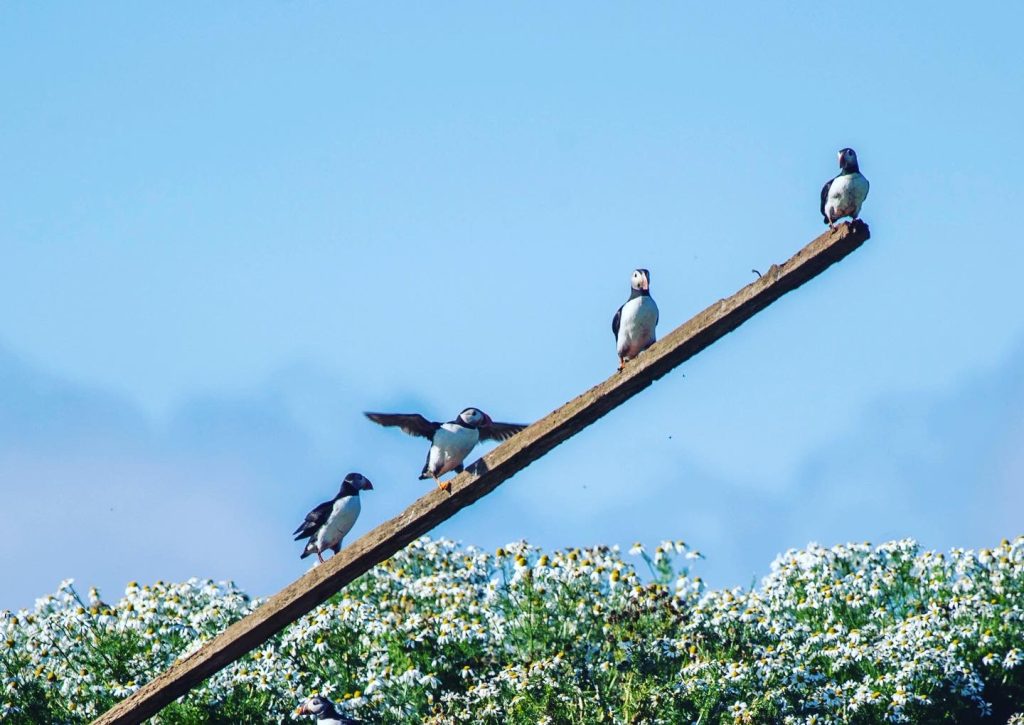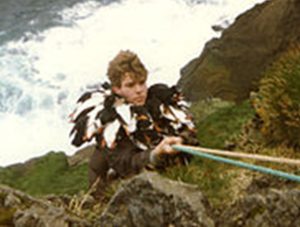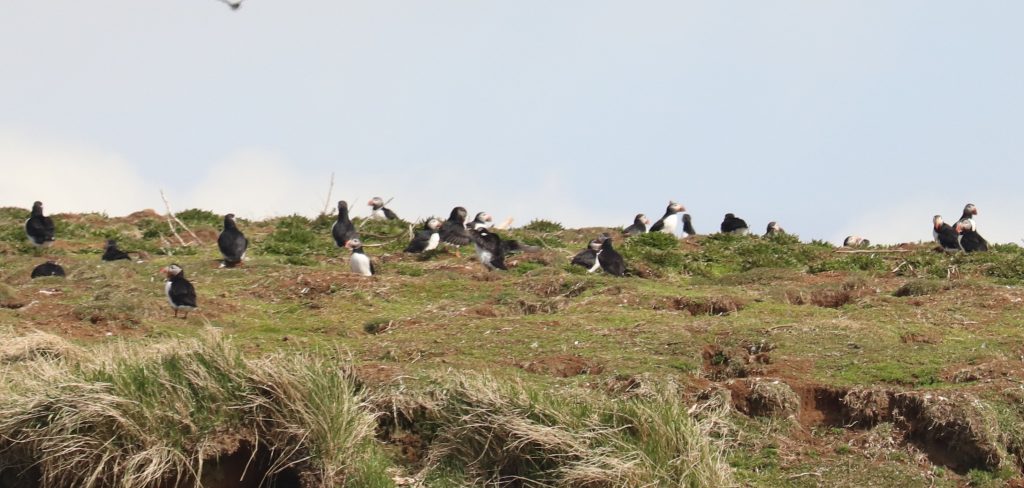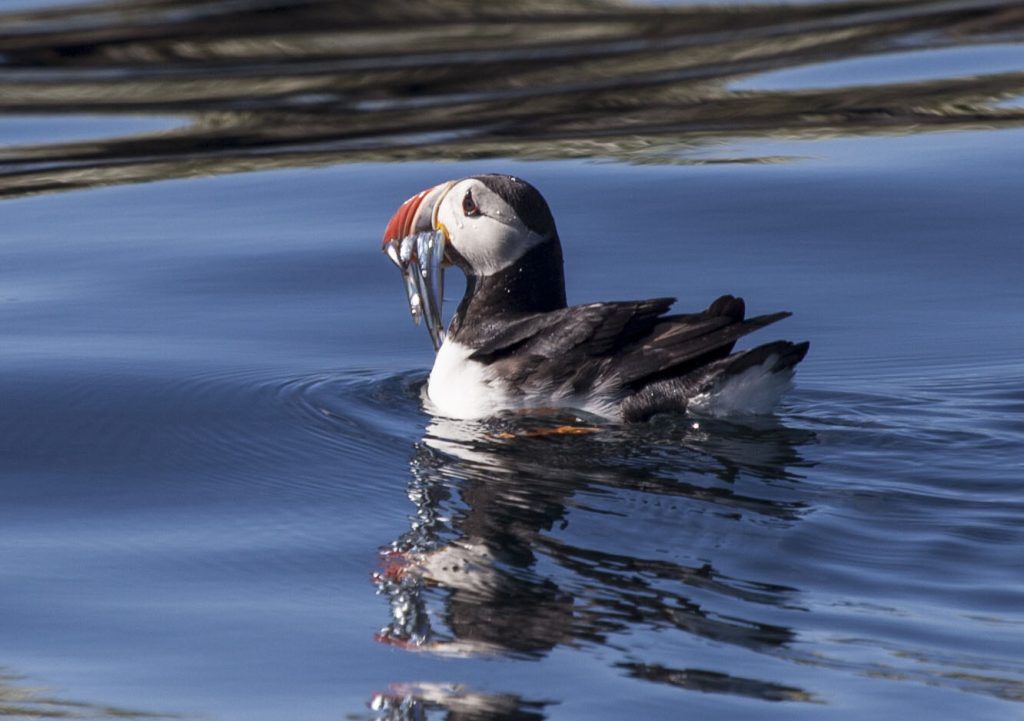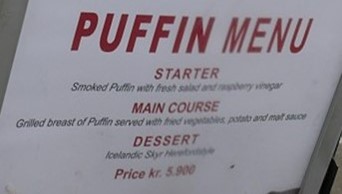As a visitor in Iceland or an enthusiast about birds, you may wonder about the state of the puffin – how it’s faring against climate change, volatile weather conditions and human impact. This article covers some of the most important factors relating to puffin survival, including puffin hunting and changes in natural conditions. Let’s start by looking at perhaps the hottest topic: puffin hunting.
Why would you want to hunt such a cute and wonderful bird? Some of you might ask. Why not? Is what some of you might answer. It seems to be delicious and quite unique in its taste. Yes, puffins are being hunted in Iceland, and yes it is one of only two places in the world (next to the Faroer Islands), where the hunt is still legal.
Right now there is a lot of discussion about this practice and I will tell you what the fuss is all about. Remember that hunting puffins is basically as old as the the Icelanders themselves. They have pretty much done it since their Viking ancestors arrived on the island, because they probably knew it from other places in their territories. Hell, there is a whole festival in the Westman Islands (since 1874), where the biggest puffin colony resides, that is inseperable of the enjoyment of smoked puffins, which to this day is considered a delicacy.
And it does make sense. The Atlantic puffin (Fratercula arctica) is still the most common bird in Iceland with millions of pairs nesting on many of the steep cliffs. Take abundance and tradition and you have two very strong arguments to keep up this practice that is past on from generation to generation without much alteration or change. The technique has basically been the same all along. No guns are used. It is quite a simple technique: you attach a triangular net on an up to 4m long pole and voila- you have your háfur (Iceland) or fleyg (Faroer); the pole that is used to catch the puffins since centuries. Sounds simple, but actually requires a lot of skill to catch those puffins in their flight.
Want some proof? Even Gordon Ramsay tried it in a very controversial Youtube Video from 2008. After hours, he finally managed to catch a puffin. The first one of the season! Traditionally that one is released for good luck. With some more practice, he went on to catch two more and after the neck is broken and the chest meat is taken out, followed his Icelandic teacher in eating the raw heart of the puffin. Leaving the showman aspect of this particular hunt, we have to keep in mind that Iceland is a very scarse country, where survival has never been guaranteed. Under such harsh conditions, easily accessible animal protein was crucial for the survival of the settlers.
A skilled hunter could catch a few hundred puffins in a single day, providing enough food for himself and the community. In that fashion even in the 1970s approximately 150,000-200,000 puffins were killed in Iceland alone. Icelandic hunters have long kept track of their catches (since 140 years!). That enables scientists even today to look at the numbers of puffins and how puffin survival is affected by different factors.
That‘s also how we know one thing: Things have changed. The hunters were the first to recognise this, as it got harder to hunt plenty of puffins – simply because there are not so many around anymore. The hunting had to change with the dropping numbers. Over the time the hunting season has been shortened and shortened. While it was 46 days long just a couple of years ago, they cut it down to just a week in 2021. Now the hunting season in South-Iceland is only three days long. In fact, it‘s such a short season that many of the more passionate hunters that do it travel to the North, to Grímsey, where the hunting season is longer (~6 weeks). Still, hunting has decreased by 90% in comparison to the 1970s (still reaching about 15,000-20,000 birds each year). What is happening?
Puffin populations are struggling. Especially in the Westman Islands, where researcher Erpur Hansen speaks of a breeding failure since 2003. Almost no subadults are recruited into the breeding populations with the consequence of an alarming 70% decrease over the last 30 years. And it doesn‘t look much better for the rest of Europe. In total the population is calculated to be declining at a rate of 50-79% over three generations (65 years) according to new data from the IUCN. That has led the puffin to be listed as vulnerable, with some populations on the European level even as endangered (IUCN 2018). Because Iceland and Norway together hold about 80% of the total population in Europe, their status here is of the utmost importance for puffin survival overall.
But what are the factors for such a drastic decline? It surely isn‘t all to blame on a few hunters right? Indeed the problem is way more complex and has to do with all of us, not just some hunters. One of the most important factor is the warming of the climate due to human activity. The puffins’ main prey species in (the South) of Iceland is the sand eel. It thrives at a sea surface temperature of around 7,1°C, with rates of puffin survival and reproduction dropping the more temperatures vary. Just like the young herring and the capelin (other staple foods for the puffin), they are cold water fish. And they are being fed to the young puffins!
Because of the warming sea water, prey populations are dying. Or they are pushed further North, out of reach for the puffins in their breeding colonies. That is one reason why puffin survival around Grímsey is still comparably better than in the Westman Islands, where sand eels have vanished. In the absence of enough prey, the parent puffins must fly further and further away to find enough food to feed their young, very energy taxing and often not sufficient, which results in the starvation of the young.
As if that wasn’t already a big enough problem, overfishing is another important factor further decimating prey stocks for the puffins. Sand eel is not being eaten directly by humans, but it is further processed into fish meal and fertilizer. It’s the same for capelin. I don’t have to tell you much about herring.
So, what role does hunting play in the overall decline of the puffins? According to lead scientist Hansen, breeding puffins tend not to fly into the nets of the hunters, because they fly directly in and out of their burrows while it is the young adolescents that fly along the cliffs more aimlessly. They are the ones that are being caught by the hunters. He subsequently called for a hunting ban. Hunting seems to account for about 10% of the recent decline, because it has robbed the populations of an upcoming breeding generation while the reproduction performance of an aging population decreases more and more. Therefore, any hunting of puffins is considered ecologically unsustainable.
Why this might be interesting for you? Let’s say you’d walk through Reykjavik and come across a restaurant that still serves puffin meat. Puffin „harvesting“ has for the longest time been a local activity, where the inhabitants hunt in their local, unforgiving environment for survival. But things have changed and curious tourists are creating a demand for puffin meat that wouldn‘t exist without them. I believe through the given information you are enabled to make a reasonable decision with puffin survival in mind. Although curiosity is strong in us, you just have to ask yourself, if you think that eating such a unique and wonderful bird that is in severe decline is a bright idea? If you are still not convinced, I’d love to show you the beauty of these birds on one of our Puffin Express or Puffin Express by RIB Speedboat tours here at Special Tours.
As always, thanks for reading and hopefully see you soon.
Blog by Daniel Blankenheim, Special Tours guide
PS: As of the 29.05.2023, there is news about hundreds of dead puffins (among other sea birds) being stranded dead in the Westman Islands. We don’t know exactly what is happening right now and are waiting for data to be released. There is reason to believe these deaths are the result of bird flu, which has wreaked havoc in several countries among different bird species in recent years. It certainly is alarming news for the puffin population in Iceland that is already struggling.
Sources:
Kevin, B. (2016). The burning man of Birding: Inside Iceland’s Puffin festival. [online] Available at: http://www.audubon.org/magazine/november-december-2015/the-burning-man-birding-inside [Retrieved 26/05/2023]
BirdLife International (2023). Species factsheet: Fratercula arctica. Downloaded from http://datazone.birdlife.org/species/factsheet/atlantic-puffin-fratercula-arctica [Retrieved 28/05/2023]
Dead Puffins Article: https://www-mbl-is.translate.goog/frettir/innlent/2023/05/27/hundrud_lunda_liggja_daud_i_fjorum/?_x_tr_sl=is&_x_tr_tl=en&_x_tr_hl=is&_x_tr_pto=wapp (29/05/2023)
Recent population decline: https://www.ruv.is/frettir/innlent/2023-05-21-lundastofninn-i-mun-verri-stodu-en-talid-var (24/05/2023)
Fig.1: USFWS, Photo of the week – Atlantic puffins landing (4187859337).jpg
https://upload.wikimedia.org/wikipedia/commons/thumb/4/42/Photo_of_the_week_-_Atlantic_puffins_landing_%284187859337%29.jpg/640px-Photo_of_the_week_-_Atlantic_puffins_landing_%284187859337%29.jpg
Fig.2: A puffin hunter climbing up into Suðurey in Vestmannaeyjar with his prey (CC BY-SA 3.0)
https://upload.wikimedia.org/wikipedia/commons/e/e7/Puffin_hunter_in_Sudurey.jpg
Fig. 3: Bill Ward, Puffin meat available at a restaurant in Reykjavík, Iceland (CC BY 2.0)
